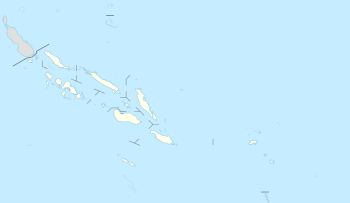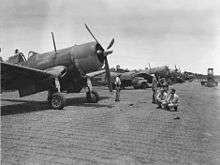Kukum Field
Kukum Field also known as Fighter 2 Airfield is a former World War II airfield on Guadalcanal, Solomon Islands.
| Kukum Field | |
|---|---|
| Part of the Pacific Theater of World War II | |
| Guadalcanal, Solomon Islands | |
 Aerial view of Kukum Field | |
| Coordinates | 09°25′34″S 160°00′39″E |
| Site information | |
| Controlled by | USAAF Royal New Zealand Air Force |
| Condition | abandoned |
| Site history | |
| Built | 1942-3 |
| Built by | Seebees/Marine Aviation Engineers |
| In use | 1943-69 |
| Materials | Coral |

World War II
From the beginning of the Guadalcanal Campaign it was planned that the area would be developed into a major air base. In November 1942 the 6th Naval Construction Battalion began work on a fighter strip at Lunga Point. The 6th Battalion was later replaced by the First Marine Aviation Engineers who completed the coral-surfaced runway by 1 January 1943. In June–July 1943 the 46th and 61st Battalions built a second coral-surfaced 4,000 feet (1,200 m) by 150 feet (46 m) runway with 75 feet (23 m) shoulders, coral taxiways 80 feet (24 m) wide, and 121 hardstands.[1] The 26th Battalion built a tank farm providing storage for 2,000,000 US gallons (7,600,000 l; 1,700,000 imp gal) of aviation gasoline, 1,000,000 US gallons (3,800,000 l; 830,000 imp gal) of motor gasoline, and 42,000 US gallons (160,000 l; 35,000 imp gal) of diesel oil.[1]:249
USAAF units based at Kukum included:
- 12th Fighter Squadron operating P-39s from 7 February 1943 – 19 February 1944
- 68th Fighter Squadron operating P-38s and P-39s from January–December 1943
- 339th Fighter Squadron operating P-38s from 2 October 1942 (det) - 1 December 1943 and 29 December 1943 - 15 January 1944
USMC units based at Kukum included:
- VMF-124 operating F4Us from 12 February–September 1943

Royal New Zealand Air Force units based at Kukum included:
- 1 Squadron operating Lockheed Venturas from October 1944[2]
- 2 Squadron operating Venturas from August–October 1944[2]
- 3 Squadron operating Venturas from July–August 1944[2]
- 14 Squadron operating P-40s from 11 June-25 July 1943[2]:186
- 15 Squadron operating P-40s 26 April–June 1943[2]:181 and from mid-September-mid-November 1943[2]:197
- 16 Squadron operating P-40s from 25 July - September 1943[2]:193
- 17 Squadron operating P-40s from mid-September-20 October 1943[2]:197
Postwar
Kukum Field remained operational after the war as a civilian airfield until 1969 when Henderson Field was modernized and reopened as Honiara International Airport. The airfield is now part of the Honiara Golf Course.
See also
References
- Building the Navy's Bases in World War II History of the Bureau of Yards and Docks and the Civil Engineer Corps 1940-1946. US Government Printing Office. 1947. p. 246.

- Ross, John (1955). Royal New Zealand Air Force. Historical Publications Branch. p. 276. ISBN 0898391873.